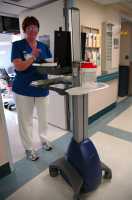
06 Nov Medical Record Doesn’t Always Reflect Medications Patient Actually Taking
MedicalResearch.com Interview with:
 Timothy Ryan PhD
Timothy Ryan PhD
This work was performed while Dr. Ryan was at
Precera Biosciences, 393 Nichol Mill Lane
Frankluin, Tennessee
MedicalResearch.com: What is the background for this study? What are the main findings?
Response: The study design is quite simple. We measured medication concentrations in patients, then compared empirically detected medications with prescribed medications in each patient’s medical record. We used this information to estimate how many prescribed medications patients had actually taken and how often they took medications that were not in their medical record. The later comparison is a particularly novel measure of the number and types of medications taken by patients unbeknownst to healthcare providers who use the medical record as a guide to patient care.
Further, the test was performed in blood and not urine, so we could obtain an estimate of how often patients were in range for medications that they did take – at least for medications where the therapeutic range for blood concentrations are well established.
In sum, we found that patients do not take all of their medications, the medical records are not an accurate indicator of the medications that patients ingest, and that even when taken as prescribed, medications are often out of therapeutic range. The majority of out-of-range medications were present at subtherapeutic levels.
MedicalResearch.com: What should readers take away from your report?
Response: Medication therapy in real-world patients is far from optimal, and there are three clear takeaways from these observational data.
- First, patient behavior is important, as many prescribed medications are not detectable in patients.
- Second, medical records are not accurate, demonstrating that interoperability between multiple healthcare provider records, particularlyfor patients taking multiple medications, is lacking as illustrated by the high detection rates of medications not in the primary medical record.
- Finally, patient biology and environmental conditions, including patient health status, the multiple concomitant medications taken, and individual drug metabolism come into play, as medication concentrations were nearly as often out of range as within range for medications actually taken by highly compliant polypharmacy patients.
MedicalResearch.com: What recommendations do you have for future research as a result of this work?
Response: This is the first large scale empirical study of medication therapy that assessed hundreds of prescription and over the counter medications simultaneously, illustrating the scope of medication therapy issues in real world patients. Being the first study of its kind, there are caveats to the quantitative interpretation of these results that can be largely overcome with larger, more comprehensive studies.
For example, some medications in the assay panel are short-lived in the body, therefore detection is dependent upon time of ingestion. We addressed this issue in the manuscript, but more carefully controlled medication-by-medication studies will better define real-world drug pharmacokinetics. Conversely, when high blood levels were detected, the patient may have just taken their drug, so studies obtaining accurate self-reported ingestion times will improve quantitative analyses.
A better understanding of why undetectable, non-prescribed, or sub/supertherapeutic drug levels are so common are warranted. For example, we showed the best predictor of whether a patient takes a given medication is whether they take the concomitant medications that they were prescribed, so learning more about patient behavior will be critical to improving compliance.
Medications detected in patients that were not in the record produced a disproportionate number of proposed drug interactions, so finding ways to improve medical record accuracy and if these proposed interactions actually manifest in patients are topics of future study. Very few patients that take multiple simultaneous medications take the same medication mix, so much larger studies will produce concrete quantitative data to address these fundamental medication therapy questions.
For example, to determine if proposed drug-drug interactions actually manifest in real world patients, we would need enough patients taking each unique pairwise combination to quantitatively determine medication exposure amidst the many variables that impact medications. Genotyping of patients taking medications known to be metabolized through polymorphic drug metabolism and transport proteins would similarly allow us to determine how important genotyping is for tittering medication dosages, a practice often used in psychotherapy.
These studies were performed when Dr. Ryan was employed by Precera Biosciences.
Citation:
[wysija_form id=”3″]
[last-modified]
The information on MedicalResearch.com is provided for educational purposes only, and is in no way intended to diagnose, cure, or treat any medical or other condition. Always seek the advice of your physician or other qualified health and ask your doctor any questions you may have regarding a medical condition. In addition to all other limitations and disclaimers in this agreement, service provider and its third party providers disclaim any liability or loss in connection with the content provided on this website.
Last Updated on November 6, 2018 by Marie Benz MD FAAD
